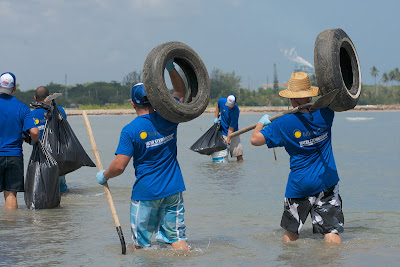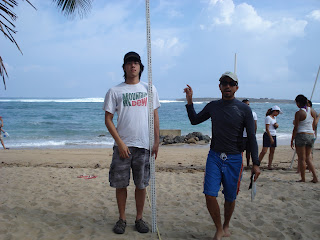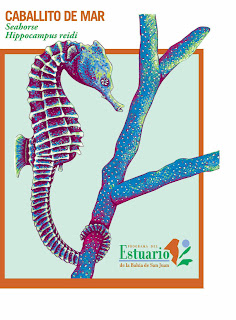Photos: Volunteers from the Capetillo community participate in the PR Water Monitoring Day; the San Juan Municipality and the DNER cleanup 1,200 tons of debris from the Martín Peña Channel; and volunteers performing beach profiles.
Our highlights for the months of April and May 2012 are as
follow:
Puerto Rico
Water Quality Monitoring Day:
Island-wide Citizen Science in practice – On April 21 more than 1,200 volunteers joined
ranks with the SJBEP to complete the 4th Puerto Rico Water Quality
Monitoring Day. Thanks to our
volunteers we were able to monitor approximately 120 water bodies along 30 municipalities.
The collected data will be submitted to the World Water Quality Monitoring
Challenge database.
Through this event we offer water-monitoring kits to persons
from all ages, which they use as a tool to interact with water bodies and
produce knowledge and information about their immediate ecosystem. This year the person in charge of the
coordination of the event was Gladys Rivera.
We want to thank our sponsors and collaborators: the
Environmental Protection Agency, the Environmental Quality Board, the Jobos Bay
National Estuarine Research Reserve, and the Puerto Rico Water and Environment
Association.
Related news:
Staggering 1,200 tons of
debris removed from the Martín Peña Channel- The San Juan Municipality and the Department
of Natural and Environmental Resources (part of our Management Conference),
performed this massive mechanized cleanup that began in February 29 to March 2,
2012, and continued during May 25, 2012.
The effort took ninety (90) trips to the Humacao landfill and the use of
three trucks: one (1) unit of 52 feet, one (1) unit of 25 feet, and one (1)
unit of 16 feet.
After the
cleanup the Municipality of San Juan installed signs with a telephone number
where citizens can denounce illegal dumping in the area. This event is certainly a step further
in the implementation of our Comprehensive Conservation and Management Plan
(CCMP) and the restoration of the Martín Peña Channel.
EPA’s
Evaluation Committee: The Program
at its highest point in eleven years
– Every four years the San Juan Bay Estuary Program - as well as all organizations
affiliated to the National Estuary Program- undergoes a rigorous evaluation
from the Environmental Protection Agency’s headquarters. On this occasion the entity’s Executive
Director, Dr. Javier Laureano, welcomed the Evaluation Committee in San Juan
from April 29 to May 1st.
On May 1st the Board of Directors convened and EPA officials
announced the preliminary results of the evaluation, agreeing to pass the SJBEP
for another four years. The
Evaluation Committee spokesperson, Noemí Mercado, expressed that at this moment
the San Juan Bay Estuary Program is at its highest point of development of the
last eleven years.
The PR Daily Sun covered this key evaluation visit:
Two tons of
debris removed from the Ausubo Creek Riparian Restoration, planting begins– The San Juan Bay Estuary Program is part of an
alliance to study and restore the Río Piedras river, the main freshwater source
of the San Juan Bay. The
National Science Foundation sponsors the Río Piedras initiative through the San
Juan Urban Long Term Research Alliance (ULTRA).
Thanks to the Special Fund of the San Juan Bay
Estuary Program, the organization was able to further the restoration of two
acres of a riparian ecosystem related to one of the tributaries of the Río
Piedras river, the Ausubo creek.
The organization removed two (2) tons of debris from the
area and one (1) acre of invasive vegetation, rearranged the land banks near
the creek to improve its drainage, and distributed seven trucks of wood shavings
to improve the survival rate of new trees being planted in the two acres.
On May 26, 2012 several volunteers planted endemic
species in that area donated by the Puerto Rico Conservation Trust, and during
the summer volunteers will be watering the trees. Other partners contributing to the Ausubo Creek Riparian
Restoration include the Arboretum de Cupey, Scuba Dogs Society, Grupos
Ambientales Interdisciplinarios (GAIA), and Boricuá.
Climate change:
Beach profiles begins- As part of the SJBEP’s initiatives to study the effects of
Climate Change on the coast, Ernesto Olivares, who is our Monitoring
Coordinator, conducted the first beach profiles in the Piñones area. The event took place on April 5 and 16,
2012. Through these measurements
the organization is analyzing coastal erosion and sea level rise.
We thank the students of
Dr. Elvia Meléndez from the University of Puerto Rico for including the
activity as part of her classes, and her students for volunteering. The organization also thanks Dr. Delmis
Alicea (UPR/ UMESCO) and Ruperto Chaparro from Sea Grant for donating the
instruments needed to complete the profiles.
Scientific
and Technical Committee (STAC) meeting
to discuss the Martín Peña Channel’s
dredging– On May 18, 2012 the SJBEP held a special STAC meeting with the
purpose of discussing the latest version of the Feasibility Study for the
Martín Peña Channel Dredging. All
major state and federal agencies participated. The meeting was organized in alliance with the Enlace
Project of the Martín Peña Channel, the government organization who is
sponsoring the Feasibility Study.
Environmental
Challenges and Restoration Projects in Los Angeles: a lecture by Dr. Shelley
Luce – On May 1st, 2012 the
SJBEP hosted a presentation held by the Executive Director of the Santa Monica
Bay Restoration Commission, Dr. Shelley Luce. The lecture focused on coastal restoration
projects and sustainable initiatives
aimed at correcting the problems of
urban runoff and water supplies, as well as the rehabilitation of streams
and wetlands in densely populated areas
of Los Angeles,
California and the Santa Mónica Bay. The activity took place at 9:00
am in the conference room of the Office of the Secretary of the Department of Natural
Resources.
Estuary
Guardians’ academic year closing event - On May 19th, we celebrated the conclusion of our Estuary
Guardians’ academic year. A total of 60 students took part of the celebration,
which consisted of a guided tour through various regions of the ecosystem,
including Vacía Talega and Piñones’ State Forest, a marine turtle workshop, and
a cultural activity in COPI. In the event students were able to exchange
technical knowledge and data to further improve their monitoring skills.
SJBE
showcased in the TV program “En ruta por” - On Friday, May 11, our scientific advisor and outreach coordinator, Dr.
Jorge Bauzá and Gladys Rivera, respectively, were interviewed as part of the television
show “En ruta por”. The segment focused on different low-impact recreational
activities within the San Juan Bay Estuary, showcasing some of the SJBEP’s
restoration initiatives such as our mangrove reforestation program in the
Condado Lagoon and our water quality-monitoring program.
“Aguas dulces/ Aguas saladas”
environmental justice communities site-specific performance workshops - Artist Fiona Templeton,
from New York and London, conducted community workshops in the following
sites: Cucharillas Wetland (Juana
Matos community), Capetillo community’s Urban Forest, Barrio Obrero and Israel
communities (part of the Martín Peña Channel study area).
Approximately
40 persons from the community attended the workshops from May 31, 2011 to April 20, 2012. As part of the project members of the
communities were able to share their dreams with the artist and a group of
local performers.
The
performers, trained by Templeton for a month, represented the dreams of the
communities in a presentation at the Luis Muñoz Rivera Park on May 20, 2012.
The event
received ample media coverage, including two full-pages, full-color at El
Nuevo Día newspaper on Sunday, April 8, 2012, named “Stories of the Bay”.
We thank the Puerto Rico’s Artistic Council and the National Performance
Network for choosing the San Juan Bay Estuary for the development of this
unique experience.
Visit from Nancy Stoner,
EPA’s Deputy Administrator for the Office of Water- Nancy Stoner is the person from
EPA in charge of the Office of Water. Thanks to an invitation from Judith Enck,
Stoner visited several environmental justice communities of the San Juan Bay
Estuary Program. The visit took
place on April 13, 2012
Stoner
wrote the following excellent article about her visit to the Program:
On May
15, 2012 Bernice Smith, the National Estuary Program’s Director in DC, sent a communication
to all NEP directors and EPA regions to inform about this relevant visit and
congratulate the SJBEP for its fine work.
SJBEP speaks to the New York Federal Reserve - On the second of May, Dr. Javier Laureano presented
to the executive staff of the New York Federal Reserve the economic relevance
of the SJBE's ecosystems.
Among the attendees to the presentation were Christine
Cumming, First Vice President of the Federal Reserve Bank; Richard Peach,
Senior Vice President; and Rae Rosen, Assistant Vice President. After the
meeting, the members of the NYFR visited our mangrove
planting and artificial reef restoration projects in the Condado Lagoon.
Alliance
with Cantera presented in a press conference– On April 19th, Dr. Javier
Laureano, and STAC President Ernesto Díaz participated in a press conference
organized by the Company for the Integral Development of the Cantera Peninsula
to announce the alliance of the Company with the SJBEP and the DNER.
One of the projects discussed during the event was the
Guachinanga channel’s dredging. The
SJBEP and Cantera have destined an investment of $400,000 for this initiative.
Related news:
















